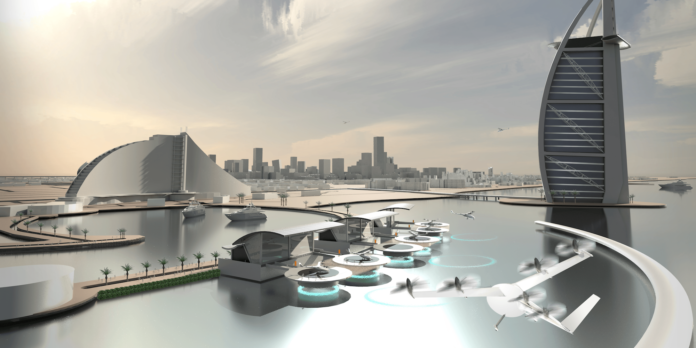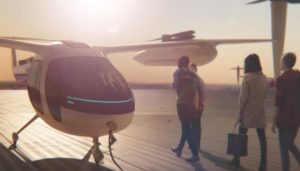
The flying car has seeped into our imaginations, becoming the telltale sign that we’re living in an advanced, futuristic world. The Jetsons certainly became my standard for high-life futuristic living with their robot maid and flying cars. While I’m still working on getting a robot maid (a Roomba just doesn’t quite cut it…), it seems the notion of flying transportation may be near in our future. Just a few short years from now, in 2020, Uber is hoping to take transportation to the next level by moving from the streets up into the skies.
Uber has created Uber Elevate. With Uber Elevate you’ll be able to skip the drive to work and instead fly above the traffic congestion when you hop on a VTOL aircraft that you’ve summoned with your phone (just like you would an Uber car). VTOL, pronounced vee-tol, stands for “vertical takeoff and landing”. A VTOL looks and operates similarly to a helicopter though with Uber’s model, the VTOL uses electric propulsion producing zero emissions and designed to be much quieter than a helicopter so as not to add noise pollution to cities.
For anyone who has tried to get through the Lowry Tunnel during rush hour, you might already be trying to book your ride to work on a VTOL aircraft. That time waste and frustration is the main impetus to devising Uber Elevate. Millions of hours are lost because of our commutes. Uber states, “The average San Francisco resident spends 230 hours a year commuting between work and home.” That is less time spent with family, less time with friends, less time being productive at work, and more money on fuel and car expenses. Uber is hoping to “radically improve urban mobility” with quicker commutes, less traffic congestion, and cleaner air.
In a white paper Uber produced the company explains,
“Just as skyscrapers allowed cities to use limited land more efficiently, urban air transportation will use three-dimensional airspace to alleviate transportation congestion on the ground.”

While the idea of casually commuting to work via flying aircraft is quite exciting, Uber Elevate still has many obstacles to navigate before takeoff. One hurdle consists of developing the infrastructure to support VTOL aircraft. This new infrastructure would include building ‘vertiports’. A ‘vertiport’ is a VTOL aircraft hub comprising of multiple takeoff and landing pads as well as charging stations for the vehicles. Vertiports would need to be constructed all around the cities and suburbs in order for Uber Elevate to be effective. As of now, Uber plans to build vertiports on existing helipads, on top of parking garages, rooftops, or on unused land around highway interchanges. Uber believes in the long run creating this new infrastructure will be more cost effective than continued work on building and repairing roads, rails, bridges, and tunnels.
With VTOLs whizzing around the skies, another barrier will be complying with aviation regulations from the US Federal Aviation Administration and European Aviation Safety Agency. Uber is hoping to alleviate issues that could arise with the increase of airspace use by working with NASA to create a central air traffic control system for safe flying at lower altitudes.
Even will these challenges, in the year 2020 Uber Elevate will begin its test runs in Dallas, Dubai, and Los Angeles (certainly these cities could use some relief from traffic congestion). While the Twin Cities is not currently on the list for testing Uber’s flying vehicles (I imagine our winter months will provide its own unique set of challenges), if Uber is successful in other cities we may actually get to experience living in the Jetsons’ futuristic world sooner than we thought.
















